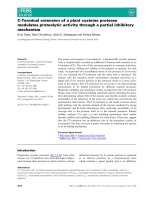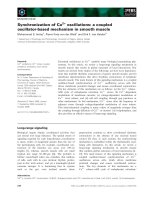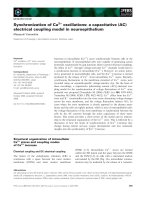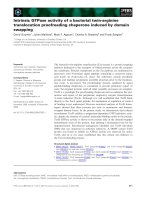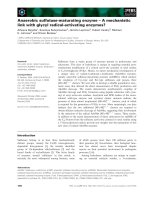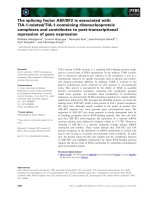Tài liệu Báo cáo khoa học: Neuronal growth-inhibitory factor (metallothionein-3): a unique metalloprotein ppt
Bạn đang xem bản rút gọn của tài liệu. Xem và tải ngay bản đầy đủ của tài liệu tại đây (126.15 KB, 1 trang )
MINIREVIEW SERIES
Neuronal growth-inhibitory factor (metallothionein-3):
a unique metalloprotein
Zhong-Xian Huang
Chemical Biology Laboratory, Chemistry Department, Fudan University, Shanghai, China
Metallothionein (MT) was first identified in 1957 by
M. Margosch and B. Vallee as ‘a cadmium protein
from equine kidney cortex’. In fact, the small protein
was a Cu, Zn-containing protein, with an array of con-
served cysteine residues. Since its discovery, intensive
study has been focused on this protein, but its func-
tions remain elusive.
In 1991, a new small protein, which exhibited neuro-
nal growth-inhibitory activity, was isolated by Y. Ush-
ida et al. from healthy human brain; this protein was
subsequently named neuronal growth-inhibitory factor
(GIF). It was later found that this protein showed high
sequence similarity ( 70%) to MT, together with con-
served cysteines and metal content, and it was renamed
MT3. The neuronal growth-inhibitory activity of this
protein is unique among members of the MT family. In
their paper, Ushida et al. wrote that: ‘‘… we do not
know the mechanism of growth inhibitory action of
GIF, especially why GIF but not MT has growth inhib-
itory activity, despite [their] homologous sequences.’’
To answer this question we have been carrying out a
study of structure–property–reactivity–function rela-
tionships. Owing to the conformational flexibility of its
polypeptide chain, there is no GIF crystal structure
available as yet. The solution structure of the a-domain
of rat and human Cd-GIF has been determined by
means of NMR spectroscopy, but the structure of the
b-domain could not be solved because of insufficient
NOE connectivities. However, a model of the b-domain
structure of GIF was constructed on the basis of molec-
ular dynamic simulation, and a systematical mutagene-
sis study has been performed. This has revealed that
the particular conformation of TCPCP(5–9) in the
b-domain, the exposure of the metal–thiolate clusters,
the dynamics of EAAEAE(55–60) in the a-domain and
the interdomain interactions are closely connected to
the bioactivity of human GIF, as discussed in the first
minireview of the series.
The two-domain architecture of proteins in the MT
family gives rise to their specific properties, such as
binding to metals for detoxification of pollutants and
homeostasis of essential metals, and a supply of thiols
(cysteines) for scavenging free radicals. What then are
the differences between GIF and MT1 ⁄ 2 that confer on
GIF the specific growth-inhibitory activity? In the
second minireview, Faller and colleagues have produced
a detailed summary of possible differences in the cluster
structure between GIF and MT1 ⁄ 2. The higher dynam-
ics and greater exposure of the metal–thiolate clusters to
the outside environment in GIF is thought to result in
the high reactivity of this protein. I welcome the contro-
versy introduced in respect of previous studies. In line
with Confucian philosophy ‘
ݐ߭ᯢ
(jian ting ze
ming)’, contrary results and views can look opposite but
sometimes they are complementary, reflecting the same
truth from different aspects.
Some of the functions of MTs have been uncovered,
but the real roles played by GIF are still not clear. In the
final minireview, the possible biological functions are dis-
cussed by Chung and coworkers. Taking into account
the expression and secretion of GIF in brain, and com-
bining studies of neurodegenerative diseases with those
of the injured brain, they describe how GIF has neuro-
protective functions when administered to the injured
brain, as opposed to its neuro-inhibitory actions upon
cultured neurons. These authors conclude that ‘the stud-
ies to date have only begun to investigate and understand
the physiological role of GIF within the brain. Further
studies are required to determine the function of GIF
within the normal, injured and neurodegenerative brain.’
Zhong-Xian Huang received his Bachelor’s Degree (1962) and Master’s Degree (1965) in chemistry at Fudan
University (Shanghai, China). He was appointed as Associate Professor in 1985 and as full Professor in 1993 in the
Chemistry Department of Fudan University. His main research interests include the study of structure–reactivity–
function relationships and design of metalloproteins and metalloenzymes using physicochemical, spectroscopy and
protein engineering techniques.
doi:10.1111/j.1742-4658.2010.07715.x
FEBS Journal 277 (2010) 2911 ª 2010 The Author Journal compilation ª 2010 FEBS 2911
